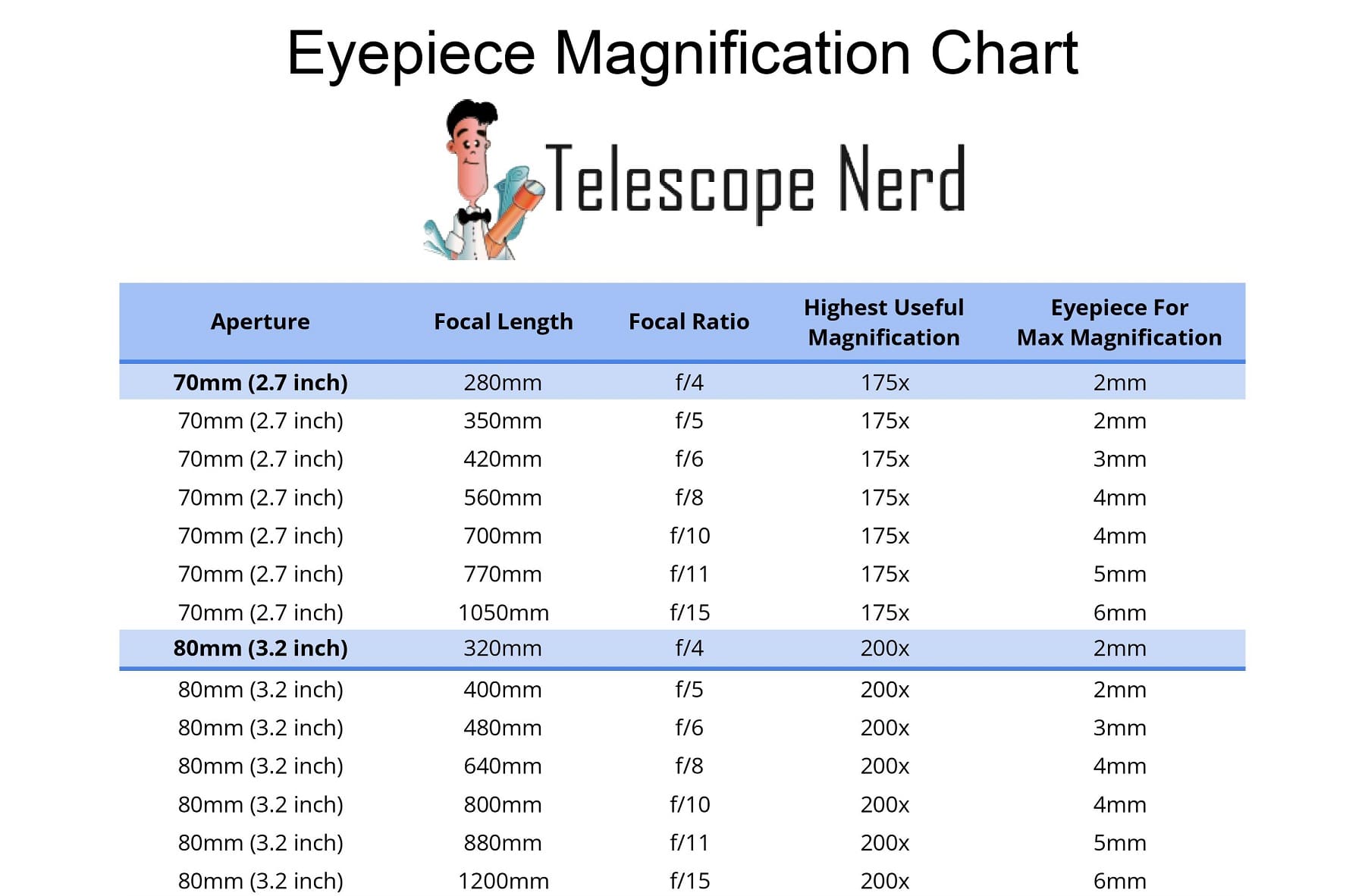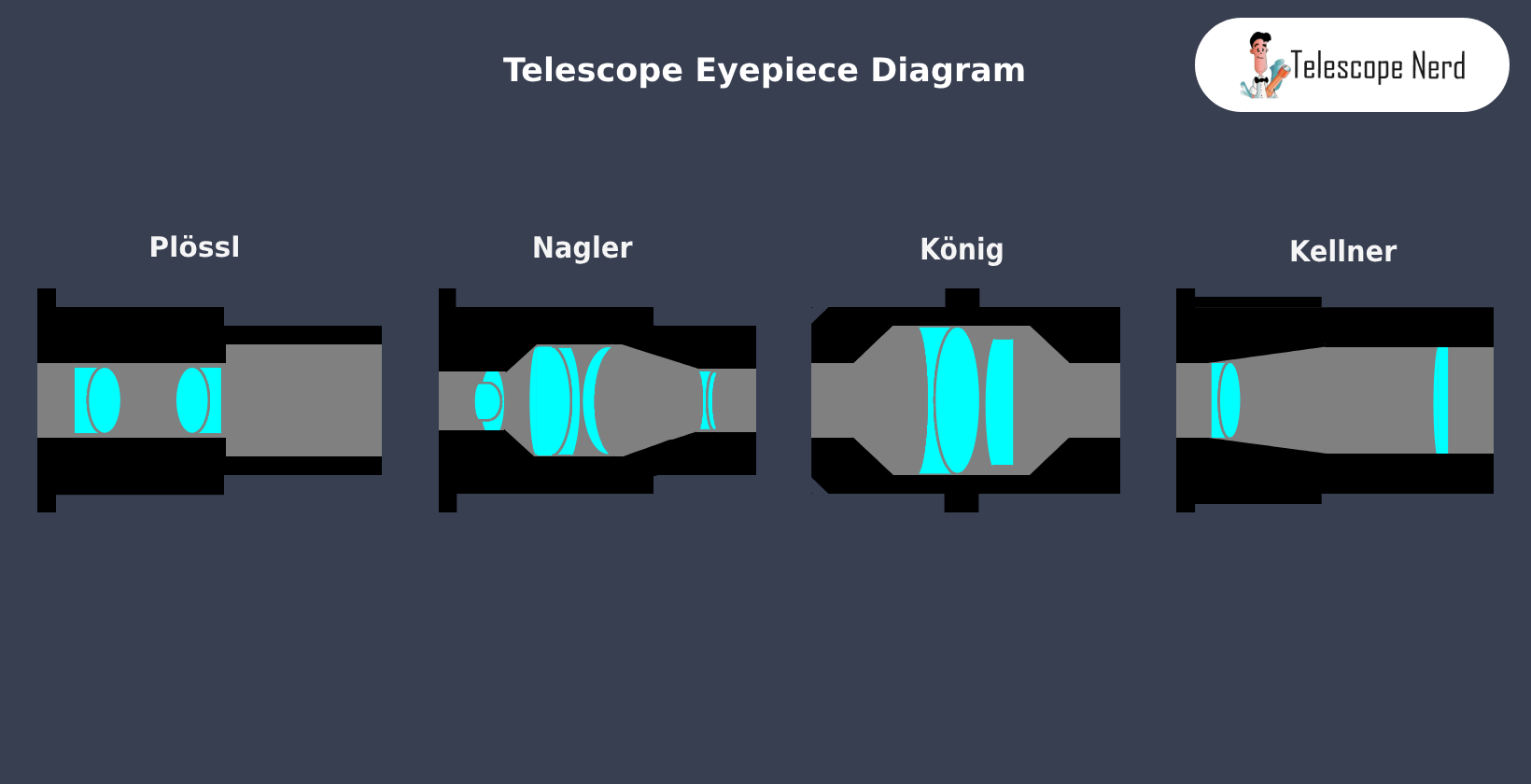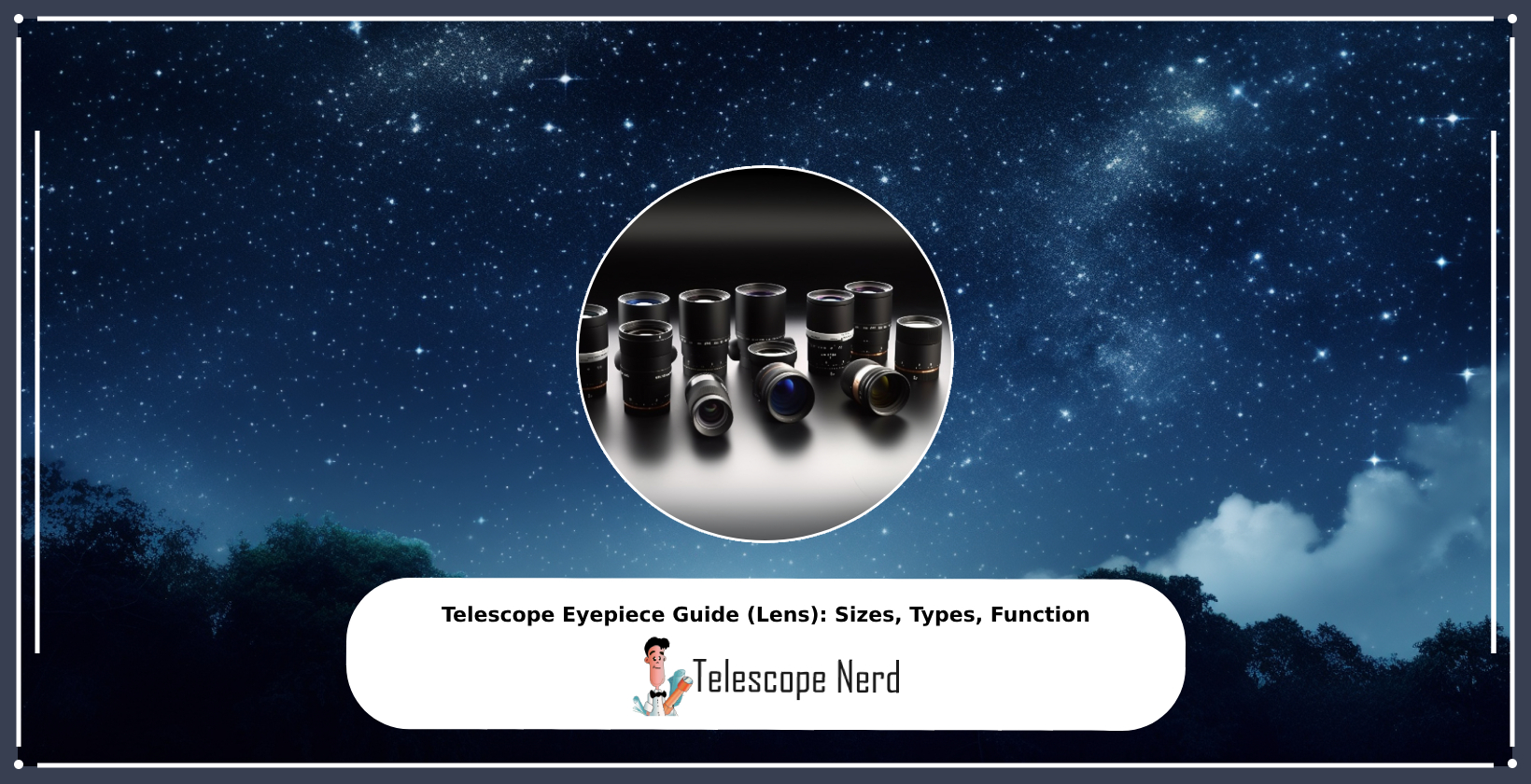Telescope Eyepiece Guide (Lens): Sizes, Types, Function
The eyepiece, often called the ocular lens or telescope eye lens, plays a critical role in determining magnification, field of view and overall clarity of celestial observations. The eyepiece is a part of the telescope through which an observer looks. The primary function of the eyepiece is to magnify the image rendered by the telescope’s primary optics. By knowing an eyepiece’s material, quality and dimensions, observers can adjust the magnification and field of view, providing the versatility to zoom in or out on celestial entities.
Eyepieces are constructed from premium glass, often augmented with specialized coatings, to optimize light transmission and reduce undesired reflections. The type of glass and coatings will affect the image’s clarity, luminosity, and color precision.
The eyepiece plays a pivotal role in determining magnification, gauged by the ratio of the focal length of the primary optics to its own. Eyepieces come in varied barrel dimensions, with 1.25-inch and 2-inch sizes being predominant. These lenses also span a range of designs, from the straightforward one lens eyepiece to the intricate zoom lens configurations. The best eyepiece models typically originate from esteemed manufacturers due to the quality of glass and coatings.
How Do Telescope Lenses Increase Magnification?
The eyepiece magnifies images using the curved design and curvature of its lenses. As light enters the eyepiece, it encounters curved surfaces, causing the light to refract or bend. This refraction process converges the light rays, resulting in a larger representation of the image as perceived by the observer’s eye.
Magnification in telescopes refers to the degree by which the apparent size of an observed object is increased. Inside the telescope, the process begins with the primary optics gathering light from a distant object and bringing it to a focal point, creating an image called the “real image”. The eyepiece spreads out the light rays that come from the primary’s real image, acting as a diverging lens. This spreading out of the real image results in magnification, making the object appear much larger through the telescope than it would to the naked eye.
The eyepiece then diverges, or spreads, the light to magnify the image for observation. The distance between the primary optics and the point where it brings light to focus is called the focal length of the telescope. The eyepiece also has its own focal length. The magnification in telescopes is determined by dividing the focal length of the primary optics by the focal length of the eyepiece.
The focal length or size of the eyepiece directly influences the magnification. A shorter focal length eyepiece will yield higher magnification, making objects appear larger but with a narrower field of view. Conversely, a longer focal length eyepiece provides lower magnification, resulting in a wider field of view but a smaller apparent object size. Thus, by swapping eyepieces of different focal lengths, an observer is able to adjust the magnification to best suit their observational needs.
What are the Common Telescope Eyepiece Sizes?
The most common telescope eyepiece sizes are 1.25 inches (31.75 mm) and 2 inches (50.8 mm). These measurements refer to the diameter of the eyepiece’s barrel, which is the portion that inserts into the telescope’s focuser.
Is a 0.965-inch (24.5 mm) telescope eyepiece considered common? While the 0.965-inch eyepiece size was once more prevalent, especially in older or entry-level telescopes, it has become less common in recent years. Many modern telescopes and accessories have shifted towards the 1.25-inch and 2-inch standards due to their versatility and the broader field of view they offer.
The size of the eyepiece influences the field of view and the amount of light the eyepiece gathers. A larger diameter eyepiece, like the 2-inch, provides a wider field of view, making it suitable for observing larger celestial objects or wide star fields. On the other hand, the 1.25-inch eyepieces are more common and offer a balance between field of view and magnification, suitable for a wide range of observational purposes.
The eyepiece size also determines its compatibility with the telescope’s focuser. Most modern telescopes come with focusers designed to accept either 1.25-inch or 2-inch eyepieces, but some are able to accommodate both sizes with the help of adapters.
How Do Telescope Eyepieces Work?
Telescope eyepieces work by taking the incoming light from the telescope’s primary optics and magnifying the image for the viewer’s eye. When light from a distant object enters the telescope, it is first gathered by the primary optics, either a lens in refractors or a mirror in reflectors. This light is then brought to a focal point, creating a real image. The eyepiece’s role is to diverge light from this image and magnify it for observation.
Light bends, or refracts, as it passes through the curved lenses of the eyepiece. This bending of light brings the rays closer together, effectively enlarging the image before it reaches the observer’s eye. The degree of bending, and thus the magnification, is determined by the eyepiece’s focal length. The focal length of an eyepiece is defined by the distance from the eyepiece where parallel rays of light converge after passing through the eyepiece. A shorter focal length eyepiece will bend the light more, resulting in higher magnification, while a longer focal length bends the light less, offering lower magnification.
The focal length of the eyepiece also influences the field of view (FOV). A shorter focal length generally provides a narrower FOV, while a longer focal length offers a wider FOV. This means that a shorter focal length will provide a more detailed image, but a longer focal length will show a wider view of the universe.
The interaction between the eye and the eyepiece, including eye relief and exit pupil diameter, also influences how telescopes work. Eye relief is the distance from the last surface of an eyepiece at which the eye is be placed to see the entire field of view. The exit pupil diameter, on the other hand, is the diameter of the light beam exiting the eyepiece, and it affects the perceived brightness of the observed object.
Different types of eyepieces, such as the Plössl or Nagler, have varying lens arrangements and coatings, influencing factors like magnification, field of view, and image brightness. Choosing the right type depends on the specific observational needs and the characteristics of the telescope with which the eyepiece is used.
What Are The 4 Main Types of Eyepieces?
The four most common eyepiece types are given below.
- Plössl
- Nagler
- König
- Kellner
1. Plössl
The Plossl eyepiece is known for its symmetrical design with two sets of doublet lenses. This configuration is crucial because it ensures that the lenses are equidistant from the focal plane, which in turn minimizes optical aberrations. As a result, users get a clearer view of celestial objects.
The Plössl offers a moderate field of view, around 50°. The primary purpose of the Plössl eyepiece is its ability to provide clear and detailed images of a wide range of celestial objects. This design reduces chromatic aberration, ensuring that stars and planets appear true to their colors.
2. Nagler
The Nagler, named after its designer Al Nagler, is a distinct type of telescope eyepiece known for its ultra-wide field of view. The Nagler eyepiece provides an expansive field ranging from 82° to 100°.
The design of the Nagler is more complex than most common eyepieces. The Nagler employs a series of lens elements in a unique arrangement, including a diverging lens to spread out light, to provide a broader field of view and reductional of optical aberrations.
3. König
The König is a type of eyepiece characterized by its wide field of view, typically containing four or more lens elements in a non-symmetrical design. The König design offers a wide field of view, usually between 50 to 70 degrees. This design typically employs a simple two or three-lens configuration. These lenses, often larger with a unique curvature, are strategically designed to minimize the number of air-to-glass surfaces, reducing potential light loss due to reflections.
The König’s primary use is to provide astronomers with clear, wide views of celestial bodies while minimizing optical aberrations. The Konig design is renowned for its balance between simplicity and performance, especially among those who desire a broad observational field without delving into the intricacies or costs of ultra-wide eyepieces.
4. Kellner
The Kellner eyepiece is a three-lens design, with the lens elements arranged in two groups. This design offers a moderate field of view, typically around 40 to 50 degrees. The Kellner design is known for its sharp central field, but it exhibits chromatic aberration at the edges.
The Kellner design is especially well-suited for lunar and planetary observations, due to the reduced chromatic aberration. This design’s commonly used because of its ability to offer a blend of performance, simplicity, and affordability.
Different eyepiece types cater to various observational uses. For instance, while the Plössl eyepiece is preferred for detailed planetary observations due to its sharpness, the Nagler is chosen for its wider field of view when scanning the Milky Way or observing larger nebulae. The choice of eyepiece type, therefore, often hinges on the specific celestial objects one aims to observe.
Is Barlow Lens Considered an Eyepiece?
A Barlow lens is not considered an eyepiece in the traditional sense. Instead, it’s a diverging lens designed to increase the effective focal length of a telescope, thereby amplifying the magnification of any eyepiece it’s paired with. Positioned between the telescope and the eyepiece, the Barlow lens effectively doubles or even triples the magnification of the eyepiece, allowing for more detailed observations of celestial objects.
While using a Barlow lens, astronomers achieve varied magnifications without needing to swap out multiple eyepieces. This versatility makes it a valuable accessory in the world of astronomy, enhancing the capabilities of the eyepieces and the overall observational experience.
How to Use Eyepiece Lenses?
To use an eyepiece lens, astronomers must ensure that the eyepiece’s focal length is compatible with the telescope’s specifications, as this determines the provided magnification. Insert the eyepiece gently into the telescope’s focuser and secure it by tightening the set screw, taking care not to over-tighten to avoid potential damage.
When using a telescope eyepiece, proper alignment of the eye directly over the eyepiece’s center is essential to prevent image distortion. The distance maintained between the eye and the eyepiece, known as eye relief, is crucial, especially for those wearing glasses. To enhance the viewing experience, it’s beneficial to shield the eye from ambient light, either with an extended eyecup or by cupping a hand around the eyepiece. Steady breathing aids in stabilizing the view, especially at higher magnifications. For optimal clarity, the object of interest should be kept centered in the eyepiece, as the image’s edges are not be as sharp in some eyepieces.
Once the eyepiece is in place, it’s important to focus the optic precisely. Adjust the telescope’s focus knob slowly until the image becomes sharp. For beginners, it’s advisable to start with a lower magnification eyepiece, which generally has a longer focal length, making it easier to locate celestial targets. Once the target is located, switching to a higher magnification provides a more detailed view. It’s important to remember that an eyepiece offers different magnifications on various telescopes due to their unique focal lengths.
There are numerous eyepieces available, each designed for specific observations. For instance, wide-field eyepieces are ideal for deep-sky observations, while others are versatile for a range of astronomical viewing.
Can Telescope Eyepieces Be Used For Different Telescopes?
Yes, telescope eyepieces can be used for different telescopes. Universal eyepieces are crafted to fit a broad range of telescopes, irrespective of their type or brand. The purpose of universal eyepieces is to allow astronomers flexibility, enabling them to switch eyepieces between different telescopes, and enhancing the versatility of their equipment.
Can eyepieces be interchanged between different types of telescopes, such as reflectors and refractors? Yes, most eyepieces can be interchanged between telescopes. Modern telescopes are typically designed to accept eyepieces of standard sizes, typically 1.25 inches or 2 inches in diameter. This means that an eyepiece used for a refractor can also be used in a reflector, provided they share the same eyepiece diameter. While the physical fit is universal, the focuser or adapters also influence compatibility and overall viewing experience.
It’s important to consider additional accessories like a Barlow lens or a diagonal, astronomers must ensure they are compatible with both the eyepiece and the telescope. While many eyepieces are designed to be universally compatible across different telescope types, the observational experience differs based on the quality of accessories and observational requirements, such as magnification or field of view.
Is Eyepiece Dependent on Other Telescope Parts?
Yes, the eyepiece’s performance is dependent on other telescope parts. For instance, the primary mirror in a reflector or the objective lens in a refractor determines the telescope’s focal length, which in turn affects the magnification achieved with a given eyepiece. For example, when an eyepiece with a 10mm focal length is paired with a telescope boasting a 1000mm focal length, the resulting magnification is a substantial 100x.
The aperture, or the size of the telescope’s primary light-gathering component, also influences the abilities of an eyepiece. A telescope with a larger aperture captures more light, which becomes crucial when using high-magnification eyepieces, as they inherently reduce the brightness of the view. Even the best eyepiece can’t rectify the optical aberrations introduced by a telescope’s primary mirror or lens. Thus, when considering the best eyepiece, it’s imperative to account for the specific parts and quality of the entire telescope.
What Are the Best Telescope Eyepieces?
Determining the best telescope eyepieces requires consideration of several factors: their use, performance, build quality, and popularity within the astronomical community.
When astronomers refer to the best eyepieces in terms of use, one must look at how versatile they are across various observational needs. For instance, wide-field eyepieces are favored for deep-sky observations, while others are tailored for planetary viewing.
The best eyepieces offer sharp, clear images with minimal aberrations. They effectively magnify images without compromising on clarity and provide a broad field of view, allowing astronomers to observe larger portions of the sky in detail. The best eyepieces are crafted from high-quality glass, often treated with specialized coatings to enhance light transmission and reduce unwanted reflections. Their construction ensures durability and a long lifespan, even with regular use.
The brand of the eyepiece will also influence the overall quality. Some eyepieces have garnered acclaim within the astronomical community due to their consistent performance and reliability. Brands like Tele Vue, with their Nagler and Ethos lines, or Celestron with their X-Cel series, often come up in discussions about top-tier eyepieces.
The best telescope eyepieces strike a balance between usability, performance, quality, and community endorsement. These eyepieces elevate the stargazing experience, making each observation session more rewarding and insightful.

